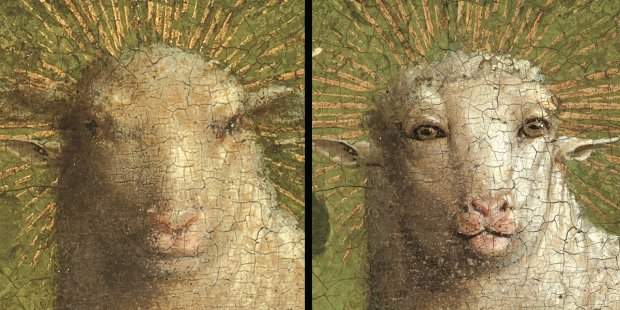Van Eyck's Mystic Lamb, restorer: "Misunderstandings about restoration arose because of stupid tweets"
She uses rather heavy words, art historian Hélène Dubois, head of the restoration project of the Polyptych of the Mystic Lamb by Hubert (? - Ghent, 1426) and Jan van Eyck (Maaseik, c. 1390 - Bruges, 1441), painted in 1432 and kept in the Cathedral of St. Bavon in Ghent (Belgium), which is currently under restoration (it will return to public view in spring 2020). Dubois lashed out at many of those who commented on social media about the outcome of the intervention: the subject of the debate was the snout of the lamb, which following the removal of the 16th-century repainting was restored to its current state. The point of the issue lies in the fact that the anonymous painter who covered the original in the 16th century gave the lamb a much more natural appearance, covering the one made by Jan van Eyck, which had a more human, or according to others cartoon-like, appearance. And memes spread on the net in which the lamb was compared to Derek Zoolander, Ben Stiller’s famous character, a model famous because he used to pose doing the duckface, thus assuming a pose vaguely reminiscent of the snout of van Eyck’s real lamb.
But, beyond the wisecracks, many were alarmed, because they were used to a lamb that was, yes, more realistic, but it was not the one painted by van Eyck, and was, as mentioned, the result of later interventions (we had devoted an article to these aspects in which we explained why van Eyck had painted the lamb that way and also tried to give us an answer as to why, in the sixteenth century, it was decided to give it a more naturalistic snout. As a result, the alarm produced negative judgments about the restoration, especially from social media users, against whom Dubois is now lashing out.
In an article published today in the New York Times, Dubois, speaking with journalist Nina Siegal, comments on the affair, saying that “a lot of misunderstandings have been spread because of tweets that were absolutely stupid and out of context.” What we see, the scholar explained, “is the original van Eyck lamb, which was repainted by someone else so as to make it look more like an animal, more anatomically correct.” And the sheep discovered with the restoration “is the one painted according to van Eyck’s intentions. It is nothing strange: it is simply not what people were used to seeing and therefore not what they expected.”
The work performed to bring the lamb back to light took two weeks. And the end result, for the scholars, was not at all surprising. “Van Eyck was not the first painter to paint a lamb in that way,” Dubois argues. “We have plenty of examples from the early Middle Ages and late antiquity, including even Roman mosaics, where lambs are depicted with these big eyes inserted frontally, looking at the viewer so that it’s clear that what we’re seeing is the lamb of God.” Of course, Dubois continues, “the lamb is much more intense than I expected, and it really impressed me. But it’s because you were used to this contained, passive lamb before, and now you have to confront it with this very strong vision of the religious symbol of Christ sacrificed on the altar. Here, Christ is conscious of his sacrifice.”
Dubois added that it was not only the lamb that was repainted in the 16th century: interventions also concerned “the draperies, the top portion of the landscape, the sky, and the view of the city. In addition, on the back of the side compartments, almost 70 percent of the surface was repainted.” The repainting of the back, moreover, is distinguished by the fact that it was a work, the scholar further states, “conducted in an extremely careful manner, done in such a way that all the contours of the figures were respected and most of the colors reproduced with pigments of the highest quality.”
Pictured: on the left is the snout of the lamb with the 1550s repainting; on the right is the one painted by the van Eycks, discovered as a result of the restoration.
 |
| Van Eyck's Mystic Lamb, restorer: "Misunderstandings about restoration arose because of stupid tweets" |
Warning: the translation into English of the original Italian article was created using automatic tools. We undertake to review all articles, but we do not guarantee the total absence of inaccuracies in the translation due to the program. You can find the original by clicking on the ITA button. If you find any mistake,please contact us.




























